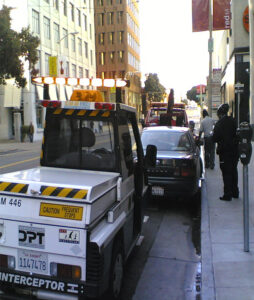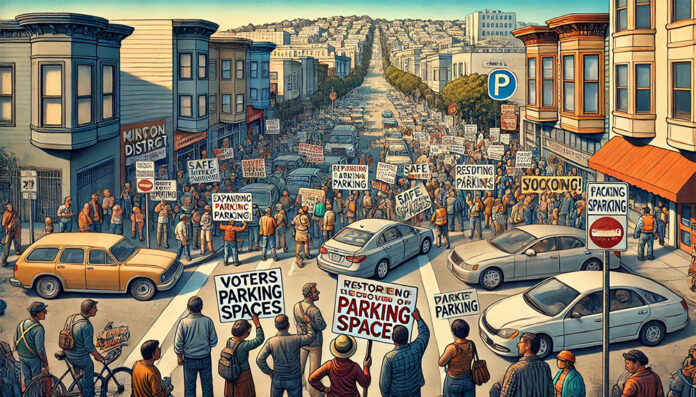The image shows how drivers face parking challenges due to ‘safe routes’ policies, highlighting the tension between sustainability and the need for accessible parking.”
Let’s urge voters to compel the City to restore all parking spaces removed over the past 20 years, build multi-level parking structures and require all new developments to include parking spaces

by Marvin Ramírez
The year 2025 will bring significant changes to urban transportation policies, with many cities focusing on expanding “safe routes” initiatives. These policies prioritize pedestrians and cyclists by limiting vehicle access, adding bike lanes, and creating pedestrian-only zones. While these changes aim to reduce car dependence and promote sustainable mobility, they also present challenges for drivers, especially those who rely on their vehicles for daily activities. Parking restrictions, a key part of these projects, are expected to impact residents and businesses, forcing them to navigate an increasingly complex parking situation.
A major concern is the growing number of parking restrictions. As cities reduce car usage, they often remove parking spaces to create bike lanes or widen sidewalks. This burdens residents, especially in neighborhoods with already limited parking, where people depend on their cars for commuting, errands, and appointments. The loss of parking spaces disproportionately affects those without reliable public transportation or those who cannot afford alternatives like taxis or rideshare services.
What exacerbates this issue is that many “safe routes” initiatives do not come with adequate parking alternatives. Bike lanes and pedestrian zones are often implemented without considering residents’ daily needs. This leads to alienation and frustration among drivers, who are forced to park farther from their homes or businesses, sometimes in areas with high fees or inadequate spaces. This lack of coordination between city planners and car-dependent residents creates a conflict between sustainable development and practical urban needs.
The introduction of higher parking fines for violations in restricted areas only adds to the discontent. As access to parking spaces becomes more restricted, many drivers risk fines or spend long periods searching for available spots. In areas with high parking demand, this becomes a daily struggle. Local businesses that rely on foot traffic also suffer, as customers have difficulty finding parking, leading to decreased economic activity and further frustration for both residents and business owners.
 One way to mitigate these challenges is for local authorities to reconsider their approach to “safe routes” initiatives. Parking removal should be paired with alternative solutions that allow drivers to access their homes and businesses easily. One option is the creation of multi-level parking structures or the introduction of more efficient parking management systems that better distribute parking spaces. Local governments could also work with businesses and residents to identify spaces that could be shared or repurposed for parking without undermining the goals of the “safe routes” initiatives.
One way to mitigate these challenges is for local authorities to reconsider their approach to “safe routes” initiatives. Parking removal should be paired with alternative solutions that allow drivers to access their homes and businesses easily. One option is the creation of multi-level parking structures or the introduction of more efficient parking management systems that better distribute parking spaces. Local governments could also work with businesses and residents to identify spaces that could be shared or repurposed for parking without undermining the goals of the “safe routes” initiatives.
If these changes are not made voluntarily by the city, the removal of parking spaces and the negative impacts of these policies could become a pressing issue that demands a broader public response. If current trends continue without regard to the daily needs of people, a citywide ballot measure might be necessary to address the issue. This measure could call for the restoration of removed parking spaces and a more balanced approach to ensuring mobility and parking are available for all residents, regardless of their preferred mode of transportation. A public vote could allow the community to shape the future of urban mobility and parking policies, ensuring that local government actions align with the interests of those most affected.
And, while “safe routes” initiatives are a step toward more sustainable and eco-friendly cities, they must not come at the expense of the residents who rely on their cars. As cities plan for 2025, it is essential that these initiatives consider the realities of urban living, including the need for accessible and sufficient parking. The city must balance promoting sustainable transportation with meeting drivers’ practical needs. If parking removal continues unchecked, the solution may lie in the hands of voters. By placing the issue on the ballot, cities can ensure all residents have a say in how their neighborhoods are shaped, guaranteeing a fair and balanced approach to urban mobility.



